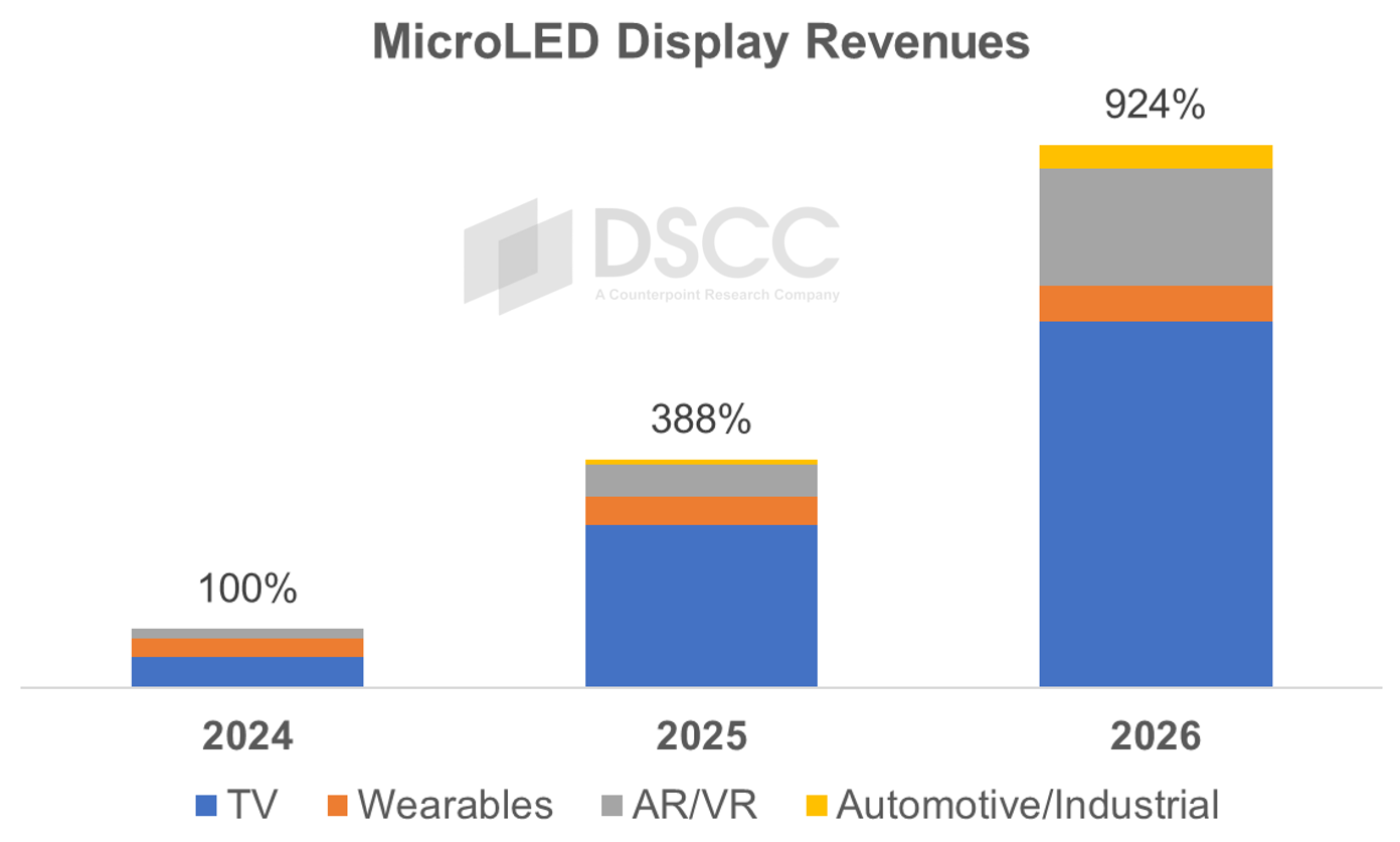DSCCがMicroLEDレポート最新版を発刊~Apple撤退後の市場成長の可能性を示す
出典調査レポート MicroLED Display Technology and Market Outlook Report の詳細仕様・販売価格・一部実データ付き商品サンプル・WEB無料ご試読は こちらから お問い合わせください。
これらDSCC Japan発の分析記事をいち早く無料配信するメールマガジンにぜひご登録ください。ご登録者様ならではの優先特典もご用意しています。【簡単ご登録は こちらから 】
記事のポイント
- 最新予測はAppleのMicroLEDウォッチ中止決定の影響を示している。
- AUOの歩留まり改善の報告を受け、同社パネル出荷数予測が引き上げられた。
- MicroLED総出荷額は2026年までに9倍になる可能性がある。
DSCCが MicroLED Display Technology and Market Outlook Report 最新版を発刊した。AppleがMicroLED搭載のApple Watchの発売中止を決定したため、今回改訂の予測は昨年版のレポートに掲載の予測とは大きく異なっている。従来はウェアラブルがMicroLEDディスプレイの最大セグメントになると予測されていたが、現在はTVとAR/VRに次ぐ第3位と見られている。
Appleの撤退によって業界が完全に危うくなったわけではない。AUOが事実上、MicroLEDスマートウォッチ分野の新たな王者となっており、同社はTag HeuerとGarminにパネルを出荷している。AUOは2024年に入って歩留まりの改善に成功しており、来年はさらなるコスト削減を計画している。MicroLEDの価格はOLEDよりはるかに高い水準にとどまると見られるが、MicroLEDはハイエンド機器やプロフェッショナル機器では有効な選択肢となりうる。DSCCはAUOのパネル出荷数予測を引き上げている。
AUOや他のパネルメーカーは車載用途もターゲットにしている。MicroLEDはLCD/OLEDの優れた代替品として、あるいは革新的なデザインを実現する透明ディスプレイとして、その実力は証明済みである。レポートには最近のデモの情報も収録している。
AR/VRについては、MicroLEDを搭載したスマートグラス製品がすでに複数販売されている。これらのディスプレイはシリコンCMOSバックプレーン上で製造されるため、LED on Silicon (LEDoS) と呼ばれることもある。MetaはMicroLEDと炭化ケイ素導波路をベースにしたスマートグラスOrionを発表した。しかし、Orionはコンセプトデバイスであり、量産はされないだろう。MicroLEDは未来のスマートグラスを実現する技術として注目されているが、フルカラーディスプレイの製造は依然、難題である。
SamsungはMicroLED TVのトップブランドであり、現在米国で3モデルを提供しており、価格は11万ドルからとなっている。OLED TVに比べて価格競争力はないが、MicroLEDはOLEDよりも大きなサイズを実現できる。そのため、MicroLEDはホームシアター向けのプレミアムソリューションに位置付けられる。TCLもこの市場に参入しており、競争によって価格にある程度の圧力がかかる可能性がある。価格が年々大きく下がっていくなら、TVセグメントが出荷額成長のおもな原動力となるだろう。このシナリオに基づけば、MicroLEDの総出荷額は2026年には2024年の9倍になる可能性もある。
レポートには2028年までの用途別市場予測のほか、以下のMicroLED関連重要トピックをすべて採り上げている。
- エピタキシーと効率の課題
- マストランスファー技術
- 歩留まりおよび欠陥管理戦略
- 量子ドットによる色変換
- バックプレーンおよび駆動スキーム
- モノリシックディスプレイ (LEDoS)
- コスト分析 (エピウェハー、バックプレーン、QD色変換)
- 競争情勢
------------------------------------
DSCCの MicroLED Display Technology and Market Outlook Report は、MicroLEDの最新動向の把握を必要とするディスプレイサプライチェーン関連企業やエンドユーザーの皆様のお役に立つレポートです。MicroLED組み込み製品を開発中のOEMをリストアップするとともに、出荷数と出荷額を用途別に予測しています。
出典調査レポート MicroLED Display Technology and Market Outlook Report の詳細仕様・販売価格・一部実データ付き商品サンプル・WEB無料ご試読は こちらから お問い合わせください。
[原文] New DSCC Report Shows How MicroLED Market Can Grow After Apple’s Exit
- Revised forecast shows impact of Apple’s decision to cancel MicroLED watch.
- DSCC increases estimates for AUO’s panel shipments after reports of improving yields.
- Total revenues for MicroLED displays could be nine times bigger by 2026.
DSCC has released the latest edition of its MicroLED Display Technology and Market Outlook Report. The revised forecast is significantly different from last year’s due to Apple’s decision to cancel the launch of the MicroLED Apple Watch. While Wearables were previously expected to be the largest segment for MicroLED displays, it now comes third after TV and AR/VR.
Apple’s exit has not completely destabilized the industry. AUO has effectively become the new champion for MicroLED smartwatches and is shipping panels to Tag Heuer and Garmin. AUO has successfully managed to improve yield in 2024 and plans to further reduce costs next year. While the price of MicroLED is still expected to be much higher than OLED, MicroLED can be a viable option in high-end or professional devices. DSCC has increased the forecast for AUO’s panel shipments.
AUO and other panel makers are also targeting automotive applications. MicroLED has been demonstrated either as a superior alternative to LCD/OLED, or as a transparent display that can enable innovative designs. Recent demos have been included in the report.
For AR/VR, there are already some smart glasses available with MicroLED displays. These displays are sometimes labelled as LED on Silicon (LEDoS) because they are manufactured on silicon CMOS backplanes. Meta has unveiled its Orion smart glasses based on MicroLED displays and silicon carbide waveguides. However, Orion is a concept device and will not be mass produced. MicroLED is still seen as an enabling technology for future smart glasses but making full color displays remains a challenge.
Samsung is the leading brand for MicroLED TVs and is now offering three models in the US, with prices starting from $110,000. While the price is not competitive against OLED TVs, MicroLED can be available in larger sizes than OLED. Therefore, MicroLED can be positioned as the premium solution for home theaters. TCL has also entered this market, and the competition will likely put some pressure on prices. Assuming prices can decrease significantly year on year, the TV segment will be the main driver for revenue growth. Based on this scenario, total revenues for MicroLED displays are expected to be nine times bigger in 2026, compared to 2024.
The DSCC report includes market forecasts by application to 2028 and addresses all the important topics on MicroLED, including:
- Epitaxy and efficiency challenges;
- Mass transfer technologies;
- Yield and defect management strategies;
- Color conversion with quantum dots;
- Backplanes and driving schemes;
- Monolithic displays (LEDoS);
- Cost analysis (epiwafers, backplanes, QD color conversion);
- Competitive landscape.
This report will be valuable to anyone in the display supply chain and end users who need to stay up to date with the latest developments in MicroLED. It lists the OEMs currently developing products incorporating MicroLED displays and provides shipment and revenue forecasts for each application.
